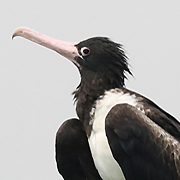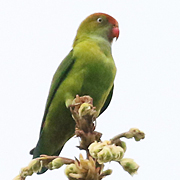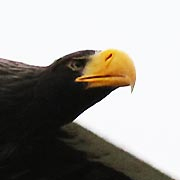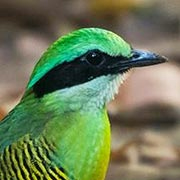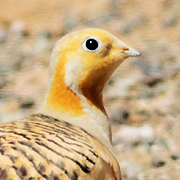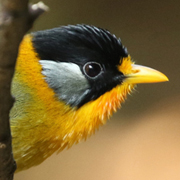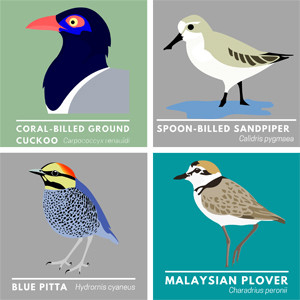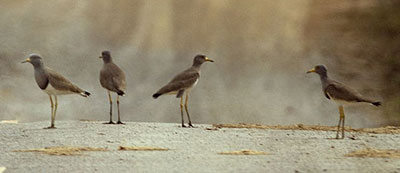
On 19th March I joined Alex Vargas on a search for broadbills at Kaeng Krachan as he was after some photographs of those species for his collection: My Birds, Thailand by Alex Vargas.
Before heading into Kaeng Krachan, however, we spent an afternoon at some paddie fields near Petchaburi before moving on to the King’s Project area at Laem Pak Bia. The paddies are always good for Green Bee-eater and Alex took some nice photos of these. We birded from the car mostly and saw a number of good birds including Pheasant-tailed Jacana, Bronze-winged Jacana, Long-tailed Shrike and a couple of raptors; Peregrine Falcon, Black-eared Kite (formerly lineatus Black Kite, split in Raptors of the World by Ferguson-Lees & Christie), Brahminy Kite and Eastern Marsh Harrier.
Moving on to the King’s Project we arrived for about 5.15 pm which is when a lot of activity is occurring with birds coming in to roost and a last flurry of activity in reed beds. In one muddy pool we found a flock of 40-50 Ruff – this spot is usually good for some Ruff but this was quite a high count. Sitting, looking along some reed beds we got great views of Slaty-breasted Rail, Ruddy-breasted Crake and White-breasted Waterhen; at one point having all three in the same field of view. We also watched Common and Pintail Snipe, dreaming about Swinhoe’s Snipe which I have been told is only reliably seperated from Pintail by its tail feathers; something which is very dificult to see properly unless it is in the hand.
As time stretched on we saw large numbers of Black Drongo coming in to roost and these were accompanied by at least 200 Blue-tailed Bee-eaters and several groups of White-shouldered Starling, numbering in between 200 and 250 birds. Other species coming in to the roost included hundreds of Common and White-vented Mynas and Asian Pied Starlings as well as 60-70 Red Collared Doves. We got a brief view of an Indian Nightjar as it settled on the road whilst we watched Black-crowned Night Herons and Fruit Bats emerge from the mangroves.
Finally we searched for an Indian Nightjar for Alex to photograph but struggled to find one, instead getting fine views of a Barn Owl. Eventually (after we had been asked to leave) we found an Indian Nightjar on the grass but just as Alex was about to photograph it, the bird flew away not to be seen again – that’s birdwatching for you!
After a nice dinner at a beachside restaurant we moved on to our accommodation at Kaeng Krachan.
20th March
Waking up early we were birding in Kaeng Krachan by 6.45am and at our first stop we found some very nice birds. Violet Cuckoo and Drongo Cuckoo were nice to see and good numbers of Thick-billed Pigeons, Black-naped Orioles and other common forest birds were feeding in a fruiting tree along with a few Oriental Pied Hornbills.
Whilst watching these and both Greater and Common Flameback we heard the manic call of a Banded Broadbill. Very fortunately for us a pair of these birds very quickly moved in and we had great views, although they never sat in a location with light good enough for the best photographs. Before moving on to the next stop we spotted a Black Baza circling in the distance and a Crested Goshawk sitting in a tree.
The next interesting bird was spotted as we drove along – a Forest Wagtail – always a nice bird and 6 or 7 more over the next 2 days indicated migratory movements. We also had a roadside Orange-breasted Trogon and Black-thighed Falconet and a number of Crested Serpent Eagles before we reached Ban Krang campsite.
At the campsite we wandered around a little and sat in the shade, waiing for birds and eating our lunch. This proved a good strategy with more Forest Wagtails, a Taiga Flycatcher with an orange throat, a pair of White-rumped Shamas, Ochraceous Bulbul, Hainan Blue Flycatcher, Blue-bearded Bee-eater and another pair of Banded Broadbills all putting in an appearance.
After lunch things were slower, as they often are when birding in the forest in Thailand, but we managed good sightings of Silver-breasted Broadbill, a wonderful species that the guidebook by Craig Robson (A Field Guide to the Birds of Thailand) does not do justice to. We struggled to see very much else with a brief view of Greater Yellownape and Emerald Dove being the most interesting species.
Slowly we made our way out of the park but stopping on the road out is always worthwhile and we saw both Hill and Golden-crested Myna, Greater Racket-tailed Drongo, Green-eared and Blue-eared Barbets and Thick-billed Pigeon to liven things up.
Back at our accommodation we heard Large-tailed Nightjar but failed to see it as it was in dense forest calling but not flying.
21st March
Another early start and we drove quickly up to Ban Krang as we wanted to be in the more moist forest early on. Our day started well with more Silver-breasted Broadbills showing themselves and plenty of the more common forest birds such as Blue-winged Leafbird, Great Iora and Rufous-fronted Babbler which is a really cute and curious character.
Close to the first stream we hit a bird wave with Grey-capped and Laced Woodpeckers, Greater Racket-tailed Drongo, Chestnut-breasted Malkoha and Asian Fairy Bluebird. For us, though, the best bird was a beautiful male Blue-and-white Flycatcher in the lower canopy. This is not a common bird at all and it was only the third or fourth time I have seen it. Another nice species was a Black-bellied Malkoha.
Things got quiet quite early on and it was noticeably hotter than it was a month ago, however, walking along we steadily picked up good birds, with a nice Moustached hawk Cuckoo that we got in the telescope, a Chinese Blue Flycatcher and a very obliging Indian Cuckoo which sat right above our heads catching insects that looked like flying ants. Another Drongo Cuckoo out in the open was also nice and a pair of Great Hornbills was heard by their wingbeats before they passed across the road – always a good bird to see!
The Brown Hornbills were not to be seen, probably we were too late for them, but a family group of bery noisy Dusky Broadbills was our third broadbill species of the trip and Alex got some good photographs of them – a fairly successful quest for this group of birds which was confirmed by another group of Silver-breasted Broadbills which gave the opportunity for the best photos yet.
With this success we went back to the campsite for some lunch and did some birding here with Black-headed Bulbul, Violet Cuckoo, Golden-fronted Leafbird, Greater Yellownape, Hainan Blue Flycatcher and Black-winged Cuckooshrike all welcomed. As we were pretty tired and feeling flush with success we decided to take a slow drive back to Bangkok. There was plenty of time to stop in the forest though and another Indian Cuckoo was a great sight but probably the strangest sighting were 2 Grey-headed Lapwings on the road in the forest! This species is normally found on wetlands unlike Red-wattled Lapwing which likes dry open areas and is commonly found at Kaeng Krachan. We watched these for some time until they began peering strangely into the sky. Up we looked and saw 3 soaring Oriental Honey-buzzards and a Crested Serpent Eagle; no wonder the lapwings seemed nervous.

Lost Grey-headed Lapwings
(Photo by Alex Vargas)
We stopped just a little further on to see some Stump-tailed Macaques and Black-naped Monarch taking a drink at a roadside pool when the lapwings flew past, with 2 more of their kind – 4 Grey-headed Lapwings in a forest!!!! The previous night there had been a thunderstorm and this species is migratory so I guess the storm had put them down in a strange spot.
This time we really did head out, stopping briefly at the HQ where we saw a few common birds such as Ashy Woodswallow, Little Egret, Cattle Egret, Kentish Plover, Little Ringed Plover, Black-collared Starling and Javan Pond Heron before taking a trouble-free drive back to Bangkok.
birds, birding, thailand, nature, national parks, photography


 March 26th, 2008
March 26th, 2008  Nick
Nick  Posted in
Posted in 
